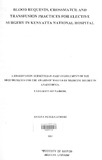| dc.description.abstract | This study was carried out over a period of ten weeks between June and August 2011 at the KNH theatres. A total of 370 patients scheduled for elective surgery whose blood had been crossmatched prior to being taken to theatre were recruited into the study. Majority of requests in the study period were requests for whole blood while requests for other blood products were rarely made. Most surgical teams made requests for two units of blood for the adults for most surgical procedures. Cross-matching of one unit of blood per patient however predominated followed by cross-matching of two units per patient.
Single unit transfusions for adult patients were the most common despite requests for two units being the majority. However in the category of children the average blood volume transfused was 18.9mllKg. The overall Cross-match to Transfusion ratio during the study period was 1.42. Most of the blood that was cross-matched (64.8%) was transfused of the patients was transfused to them. The mean estimated duration blood products were kept out of the cold chain was 17 minutes.
The methods mainly used to reduce the need for pre-operative blood transfusions included use of diathermy, pre-operative hemodilution and use of hypotensive anesthesia. The main transfusion triggers were estimated blood loss, conjuctival pallour and change in haemodynamic status. In the study subjects above 14 years, the mean estimated blood loss triggering transfusion was 750 mls. The study established that all patients received peri-operative fluids with crystalloid infusions predominating.
There was a highly significant relationship( P<O.OOI) between the type of surgery and the total fluid volume infused, the estimated blood loss, number of units requested, units cross-matched, units transfused and units not utilized in theatre. There was a highly significant relationship (P <0.001) between the estimated blood loss and the total volume of fluids infused and a significant relationship (P=0.05) between the pre-operative hemoglobin level and the total volume of fluids infused. | en_US |

